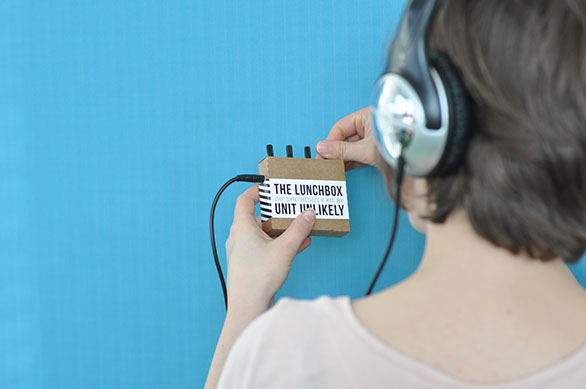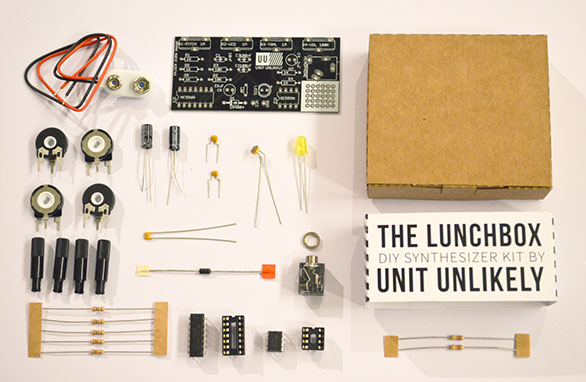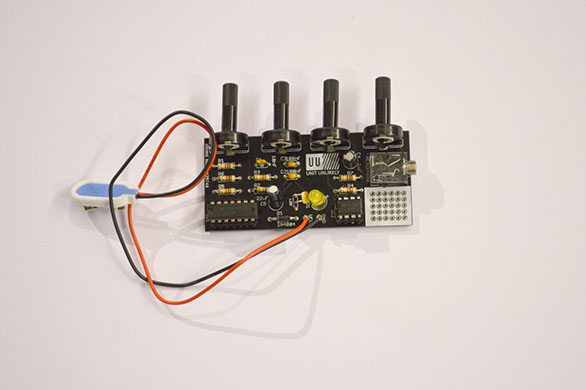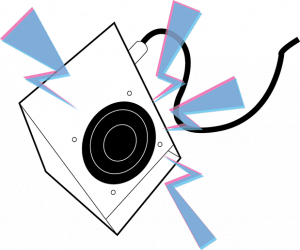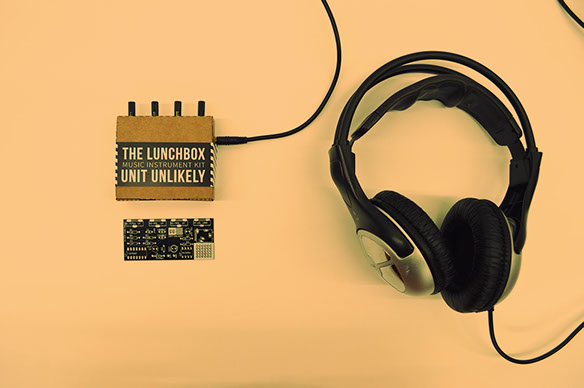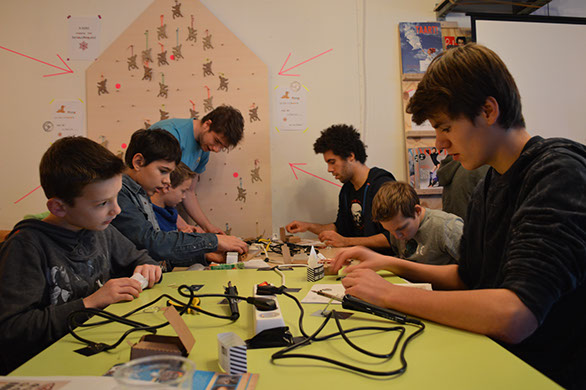[vimeo width=”640″ height=”360″]https://vimeo.com/120154304[/vimeo]
18€ buys you this lunchbox-style synthesizer kit – and it’s just the thing to put together on your lunch break.
Unit Unlikely is a hardware startup working with simple parts to make accessible, fun instruments. And its founder joins our resident Dutch design expert to talk about what it’s like diving into the synth business for the first time – and where he might go.
It all continues our series from Eindhoven, NL. From the edge of the Netherlands’ slick design scene, industrial designer and music technologist Arvid Jense joins CDM for a series of interviews with Eindhoven Music Startups. Here he talks to Unit Unlikely.
Eindhoven music startups: Unit Unlikely
Tijs Duel is a master student at the Industrial Design faculty at Eindhoven University of Technology. Together with Sebastiaan de Monte, he makes the Lunchbox synthesizer with their company Unit Unlikely. The Lunchbox is sold as a kit for €18.
How did you come to make your product?
I received my first analog synthesizer as a gift after an internship at STEIM. This was the super cool Korg Monotribe. Suddenly a whole world of making sounds opened for me. Sebastiaan (de Monte) and I thought this was fascinating. But there were not a lot of other cheap synthesizers available for us to play around with. With this dissatisfaction we thought “what if we wouldn’t only make our own sounds, but even make our own instruments which make our own sounds? What could happen if extend the creative process that much?” So we started a company to see if we could make our own synthesizers; Unit Unlikely.
For this arose the Lunchbox; a synthesizer based on three 555 timers. It’s basically a do-it-yourself, analog synthesizer which fits into your pocket, with a 9v battery and a 3.5mm output. You play it with four knobs, two for tone control, one for tremolo and one for volume. Everything is enclosed in a cardboard box, which we think is important, because we want it to be a full instrument rather than just a bunch of electronics; you’ll have something to hold on to, instead of the nasty solder points on the bottom of the circuit board. We’ve got a lot of very positive reactions, so we wanted to explore the possibilities selling the Lunchbox. To keep production costs low, we decided to make kits out of it. It shouldn’t be just a soldering practice or a toy for some weird sounds, but we want people to play songs with it or that that they use it as input for their samplers.
We started with the sale of single units at a Maker Faire. This went ok, but we saw that the task of soldering was a big holdback for people. We decided to give workshops, which turned out to be very popular. We gave workshops at for instance Dutch Design Week and for Serious Request, which were structurally sold out. In these workshops we teach people how to solder, after which they make the Lunchbox. When their synth is done, the participants circuit bend the instrument to get the whole sound making experience. If there is time left, they can hack the device by adding controls for the bends they found, so their synth will be completely personalized. (Someone modified the Lunchbox to be controlled with a sequencer.) People really like the workshops. The youngest participant was 7 and the oldest in his late 50s!
We want people to completely destroy the Lunchbox to get even more crazy sounds. The idea is that through the limitations of the instrument, it causes people to do even more interesting things; moving the borders of what is possible. Breaking down the Lunchbox and making it function in a completely different way would be the biggest honor we could have. It is our goal to have everybody building their own personal instruments.
We’ve sold over 100 lunchboxes in six months. Maybe not a super huge amount, but it takes a lot of time to do everything by hand. Except for the circuit boards, we handle all the production ourselves; the design process, distribution, printing, cutting, sorting etc. Our process is now made for a small number of units, the advantage is that we can be flexible and won’t be stuck with big batches of products to sell. If we come up with improvements or if someone comes with a genius idea, we can immediately bring out a new version.
Some people are scared of making and soldering the Lunchbox, but we’ve made a manual, slowly and clearly explaining the process, so you can make it in one and a half hour. And you’ll enjoy the device for the rest of your life, so just try it. For the people who want to buy a Lunchbox, we’re updating the website right now and are making video tutorials to demonstrate assembly. We are really happy with the people who mess around with it at home. Eventualy we hope to see artist such as Amon Tobin using the Lunchbox.
What do you think design thinking brings to electronic instruments?
The biggest difference is that someone who has studied electronics could do everything we did in half the time. But they would’ve chosen very different solutions. For instance, for the tremolo inside the Lunchbox, we’ve started making it by copying transistor based circuits like those in guitar pedals. But we felt like those were too complicated and had too many components. So we started looking for simpler methods to make a tremolo. What we found, is that we could just use the same timer as we use to generate our tones, to control a LED, which in turn shines on a light dependent resistor, modulating the sound. This also gives new possibilities for hacking, as you can now modify the sound by simply opening and closing the casing. In this way, our naivety gave us a creative solution which made the Lunchbox more interesting. It also lowered the price and amount of components, so this was an amazing solution for everyone.
We’ve started with zero knowledge about synthesizers and we went through that whole learning experience while making the Lunchbox. If you are an electronics expert making a kit, you might have forgotten the struggles of beginners of just understanding what you are making. So because we went through the same struggles as the people who will be building our synthesizers, the user basically experiences the joy of our journey of building a first synthesizer.
What are your future plans?
Version two of the Lunchbox is currently in production. It’s made just a bit better than the first one, with different components, better alignment on the circuit board (so everything will make a lot more sense when soldering), the board is a bit more compact, it’s more beautiful because it’s black, and it has a breakout area (so you can put your hacks on the circuit board itself rather than hanging them in the air). We looked to what people were actually doing right and wrong, and we adjusted the manuals, circuit boards and components to make everything work better. It’s a growing process in getting feedback from users and making adjustments. But by doing the workshops, we have a lot of contact with our users. We feel like the Lunchbox is basically finished, there might be subtle changes, but we’re quite satisfied and proud with what we have now.
We are now starting development with Pim, who recently joined us, for small amplifiers mainly for guitar and bass. A guitar amplifier kit, again in a cardboard box, weighing a kilogram, you build it yourself and it gives a bit of a tube sound. We’ve got the first prototypes and within now and March we should get the first circuit board samples. These can be pre-ordered through our website.
Whether we will continue for a long time will depend on the amount of feasible ideas we’ll get. It is a difficult blend to find things which are producible on a small scale, but are accessible enough for people to pick up and cheap enough to buy. I would love to go to a bigger scale, but while I’m still at the university, we simply don’t have the time to do that. It is a dream to make synthesizers of which people will say “Do you have that one from Unit Unlikely? It’s the shit.” Or if some of our idols would make an album with our instrument.
Why do you choose to be independent? How do you deal with investors?
As we’re just students, we don’t have much money to invest, all the money we make, we put back into the company. We’re not losing anything, but we won’t get rich doing this. We just want to be able to throw our ideas into the world. We hope to inspire the analog synthesizer community, by making playing and building synthesizers available to younger people or at least people with a smaller wallet.
Is your product Open-Source?
We’re working on it. The Lunchbox was based on the Atari Punk Console, so we won’t be able to patent it anyways. It’s a difficult balance how to make something open source so that we can teach people things, without people losing their need to buy something. We should find a way not to scare newcomers, because if you publish all schematics, people might think it’s not a finished product; That you really have to be a nerd to make it work. We want to show that everybody, whatever skill level, can make it. That it’s a finished product. We want to show how we put our blood and sweat (not that many tears) into the company, and that we don’t do it for the money. We buy and use a lot of open source things so we would love to make our product open source as well.
How is Eindhoven for you?
We’re bound here because we’re still in university. We don’t have an office; we build a lot at the university and at our own student rooms, which we rebuilt as a temporary workshop. There is a presence of an technology and music scene in Eindhoven. There are the Geluidsdrug electronic jam sessions, creating a great scene. Dutch Design Week is here of course. But I won’t say that these things are what keeps us in Eindhoven. At this point it is mostly a practical that we can’t just pack our bags and move to say Berlin. But it’s good to be here, a lot of friends and enough music around us.
What is the future of music?
What I noticed is that analog synthesizers are getting more popular and smaller. Look at the Teenage Engineering OP-1. I think everything will become more portable. I like to see the lunchbox as an audio snack for on the road.
I secretly hope that smartphones will disappear as musical controllers, because I feel like they can never become real instruments. What I think is that will happen in the future is more blends between other arts, like dancing , painting, or new synths that might make music with nature. Electronics are very useful for closing gaps between disciplines. Because they are getting smaller, it becomes more easy to use them for all sorts of tasks. You can make whole new sounds and whole new ways of creating sounds. I could combine an accelerometer and a lunchbox on a spoon, and create a whole new experience of eating soup.
It’s not the question whether that is music, but to what are the new possibilities. It could take some time to hatch, but then we get truly new music. Designers and scientist will have to make the new tools for this first, and at some point artists will rise whom can make great new music with it. It is not that we are stuck now, but there is still a whole lot more to be gained. There are infinite sounds, but we can discover a whole lot that has not been heard. I am interested in moving away from the established norms. I think we’ll keep looking for new sounds. I’m excited for it!
